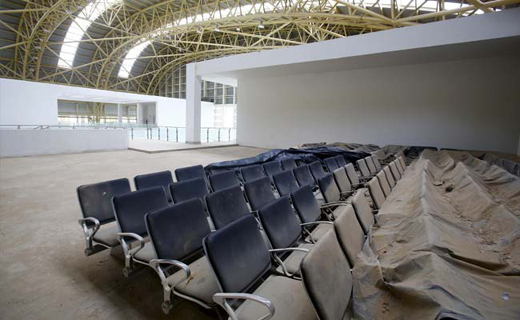India’s Ghost Terminals: Rs 325 Crore, 8 Airports, No Passengers
Mangalore Today News Network
Jaisalmer, India, Aug 19, 2015: More than two years after the completion of a new $17 million (Rs 111 crore at 1 dollar = 65.31 rupees) terminal building, the airport in Jaisalmer, the remote desert city in Rajasthan, stands empty.

Not a single passenger has passed through the gates of an airport big enough to handle more than 300,000 travellers a year, with parking bays for three 180-seater narrow-body jets.
India has spent more than $50 million or Rs 326 crore since 2009 on eight airports that do not receive scheduled flights - white elephants that are a reminder of the pitfalls for Prime Minister Narendra Modi as he bets on an infrastructure drive to fuel growth.
"They (the government) need to realise it’s not a case of ’build the airport and we will come’," said Sanjiv Kapoor, chief operating officer at SpiceJet Ltd. The private sector airline last year ceased flying to a new airport in the southern Indian city of Mysore because of insufficient demand.
India’s ghost terminals were built largely by the previous Congress-led government, which planned 200 ’no frills’ airports, encouraged by rising air travel and the need to connect far-flung regions.
But the empty check-in desks and cavernous baggage halls highlight the risks for PM Modi, too, of catering to powerful regional bosses and spending without a unifying strategy.
Across India, more than half of the 100-odd domestic-only airports operated by the Airports Authority of India (AAI) have not seen a scheduled flight this year, official data shows, though some are older airports designed primarily for chartered planes.
The AAI did not respond to requests for comment.
The Civil Aviation Ministry declined to comment on whether Mr Modi’s government will stick with the 200 airport growth plan. But the incentive to grow in less-developed regions remains: on Tuesday, Modi pledged Rs 2,700 crore ($413 million) for four new airports in the state of Bihar, which holds elections this year.
The rush to build comes as passenger numbers grow 20 per cent a year, to 38.8 million in the first half of 2015, leaving India’s major airports, which account for four-fifths of traffic, saturated.
Plans for a second hub in financial capital Mumbai are years behind schedule while the government has struggled to privatise four large airports to fund their expansion.
Courtesy: NDTV
- Mangaluru: Eight members of cattle-theft gang arrested by Bajpe police
- Belthangady Navoor murder case: Court acquits wife citing mental illness despite murder conviction
- Three blackbucks found dead with bullet injuries in Chikkamagaluru
- BJP wins majority in Kinnigoli and Bajpe Town Panchayat elections
- Mangaluru: Former lecturer loses Rs 85.68 lakh in online share market scam
- Mangaluru City Corporation acting as Congress puppet, following double standards: MLA Vedavyas Kamath
- Christmas festivities light up Mangaluru as shoppers flock for stars and crib items
- VHP, Bajrang Dal hold protest in Mangaluru against cattle smuggling and atrocities on Hindus in Bangladesh
- Expert PU college marks 40th ‘Expert Day’ with grand celebrations and academic excellence
- Removing Mahatma Gandhi’s name from NREGA is an insult to the nation: Ivan D’Souza
- DGP Alok Kumar visits Mangaluru jail, announces AI trials and tighter control measures
- Gold nears Rs 1.50 lakh per 10 grams; silver hits record high
- Vitla police constable arrested for allegedly helping Bangladeshi national obtain passport
- Rohit Sharma, Virat Kohli smash statement hundreds on Vijay Hazare Trophy return
- Uddhav, Raj announce political alliance ahead of municipal bodies poll
- We’re biggest fugitives: In new video, Lalit Modi, Vijay Mallya taunt India
- SIR 2.0: 3.67 crore voters dropped from draft electoral rolls across 11 states and UTs
- India’s ’Baahubali’ rocket places heaviest-ever satellite in orbit
- Bengaluru techie shoots wife a week after she sends him divorce notice
- Unnao rape case: Delhi High Court suspends jail term of Kuldeep Sengar, grants bail
- India announces Rs 4,000 crore reconstruction package to rebuild Sri Lanka
- Protests at Bangladesh High Commission in Delhi over Hindu man’s lynching
- Five-member gang including two women arrested for honey trapping, robbing Bengaluru techie
- Four government officers raided in disproportionate assets case in Karnataka
- Centre defends Supreme Court’s Aravalli order amid mining fears
- Mangaluru Student Goes Missing; Ullal Police Register Case
- APD Foundation Joins WHO Civil Society Commission
- Daiva’s prediction comes true: Janardhan Reddy walks free from jail
- Skills and Competencies Take Center Stage at MSN Dialogue Series
- Court remands Maoist Lakshmi to six-day police custody
- Sandhya Shenoy honored with Society for Materials Chemistry Medal-2024
- White Cornus Apartment in Mangaluru
- City girl wins first place in state-level spell bee competition
- Alleged ‘Love Jihad’ Case in Mangaluru: Woman left home voluntarily, says police
- Girl fatally struck by reckless two-wheeler near Belman
- New residential complex for the judges inaugurated in Mangaluru
- Absconding accused nabbed after 8 years
- Truck with cylinders turns turtle in Beltangady
- Bhoota Kola artist dies of cardiac arrest
- Development of the country should be our goal: Ganesh Karnik
- CITY INFORMATION
- TRAVEL
- TOURIST INFORMATION
- HEALTH CARE
- MISCELLANEOUS




 Write Comment
Write Comment E-Mail To a Friend
E-Mail To a Friend Facebook
Facebook Twitter
Twitter  Print
Print 

